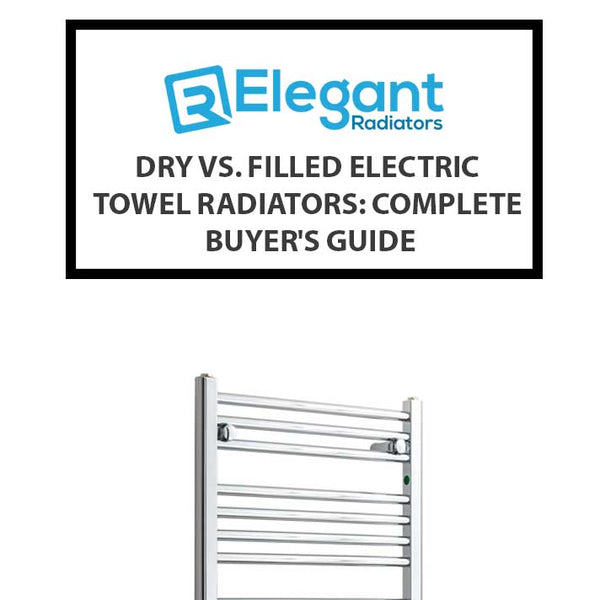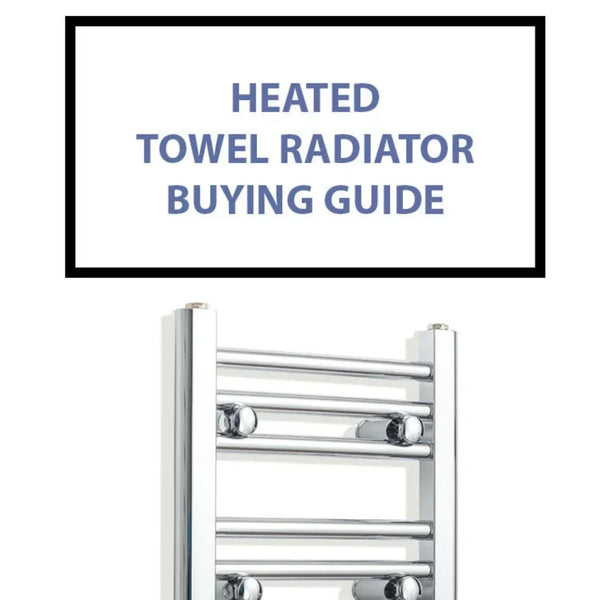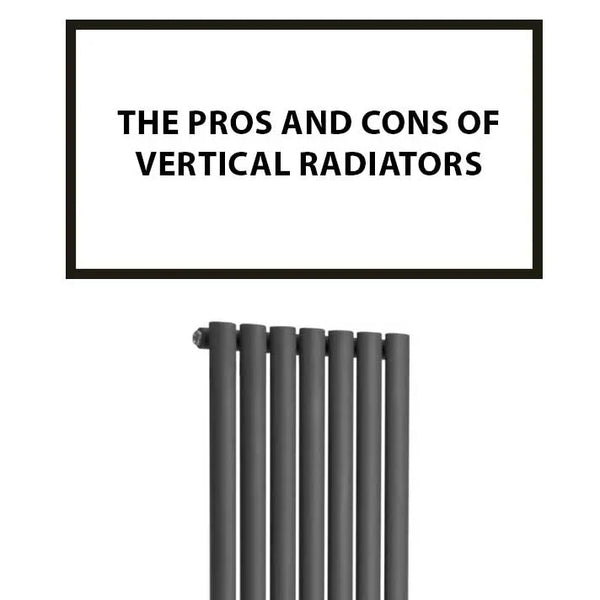Flat vs Curved Towel Rails: Which Is Better for Your Bathroom?

Choosing between a flat and curved towel rail might seem like a minor decision, but it can make a significant difference to both the functionality and appearance of your bathroom. Whether you're renovating a compact en-suite or designing a spacious family bathroom, understanding the practical differences between these two popular styles will help you make the right choice.
In this guide, we'll explore the benefits and drawbacks of each design, helping you decide which towel rail best suits your space, lifestyle and heating requirements.
Understanding the Difference Between Flat and Curved Towel Rails
At first glance, the distinction is straightforward: flat towel rails (also called straight towel rails) have horizontal bars that run parallel to the wall, whilst curved towel rails feature bars that bow outward, creating a gentle arc away from the wall surface.
This seemingly simple design variation affects several important factors, including how easily you can hang towels, how much air circulates around them, and how the rail fits within your bathroom layout.

Benefits of Flat Towel Rails
Space-Saving Design
Flat towel rails sit closer to the wall, making them an excellent choice for smaller bathrooms, narrow en-suites, and cloakrooms where every centimetre counts. Because they don't protrude as far into the room, they're less likely to obstruct doorways or walking paths particularly important in tight spaces where you need to move around freely.
Clean, Modern Aesthetic
If your bathroom features contemporary, minimalist design, a flat towel rail often complements this style perfectly. The sleek, linear profile creates clean lines that blend seamlessly with modern bathroom furniture, wall-hung vanities, and frameless shower enclosures.
Versatility Across Rooms
Thanks to their understated profile, flat towel rails work well beyond the bathroom. Many homeowners install them in kitchens for drying tea towels, in utility rooms, or even in hallways. Their universal appearance means they won't look out of place in any setting.

Benefits of Curved Towel Rails
Easier Towel Hanging
One of the most practical advantages of curved towel rails is how much easier they make hanging and removing towels. The outward curve creates additional space between the bars and the wall, allowing you to slide towels on and off without the frustration of squeezing them into a tight gap.
For families juggling multiple towels of different sizes, this convenience can be a genuine time-saver during busy mornings.
Better Airflow and Faster Drying
The curved design allows more air to circulate between the towel rail and the wall. This improved airflow helps towels dry more quickly and thoroughly, reducing the musty smell that can develop when damp towels remain in poorly ventilated spaces.
Faster drying also means you can wash towels less frequently, which saves both time and energy over the long term.
Greater Towel Capacity
Because curved rails project further from the wall, they can often accommodate bulkier bath sheets and multiple layered towels without them bunching up against the surface behind. If your household uses thick, fluffy towels, a curved rail may handle them more comfortably than a flat alternative.
Reduced Wall Contact
When towels press directly against a wall especially on a flat rail in a humid bathroom moisture can become trapped, potentially encouraging mould growth on the wall surface over time. The gap created by a curved rail reduces this risk by allowing air to flow freely behind the towels.
Heat Output: Is There a Difference?
A common question we receive is whether flat or curved towel rails produce more heat. The answer is that the shape itself has minimal impact on BTU output. Heat output is primarily determined by the rail's size, material, and the temperature of your central heating system or electric element not by whether the bars are straight or curved.
When selecting any towel rail, always check the BTU rating and compare it to your bathroom's heating requirements. A correctly sized towel rail whether flat or curved should adequately warm your space and keep towels toasty throughout the colder months.
Choosing the Right Style for Your Bathroom
The best choice depends on your specific circumstances. Consider the following factors:
Bathroom Size: In compact bathrooms, flat rails maximise floor space. Larger bathrooms can easily accommodate the extra projection of a curved design.
Towel Usage: If you regularly dry multiple towels or prefer thick bath sheets, curved rails offer more practical capacity.
Design Preference: Minimalist bathrooms often suit flat rails, whilst curved designs can add subtle visual interest and a softer silhouette.
Ventilation: Bathrooms with limited ventilation may benefit from the improved airflow that curved rails provide.
Wall Condition: If you're concerned about moisture damage or mould behind the rail, a curved option helps keep towels away from the wall surface.
Popular Finishes for Both Styles
Both flat and curved towel rails are available in a wide range of finishes to match your bathroom décor:
Chrome: The classic choice, chrome offers a bright, reflective finish that suits most bathroom styles and is easy to clean.
Anthracite and Matt Black: These darker finishes have become increasingly popular in contemporary bathroom design, adding a sophisticated, modern edge.
White: Ideal for traditional bathrooms or spaces where you want the rail to blend into white tiled walls.
Brushed Brass and Gold: For a touch of luxury, metallic finishes create a warm, elegant focal point.
Installation Considerations
Both flat and curved towel rails install in much the same way, connecting to your central heating system or operating as electric or dual-fuel models. However, there are a few practical points to keep in mind:
Curved rails project further into the room, so measure carefully to ensure the rail won't obstruct doors, shower screens, or bathroom furniture when fully installed.
Check the wall fixings. Larger, heavier towel rails particularly those made from stainless steel may require additional support such as timber noggins behind the plasterboard.
Consider the position of existing pipework if connecting to central heating, as this may influence where you can position the rail.
Frequently Asked Questions
Do curved towel rails stick out too far from the wall?
Curved towel rails typically project around 80–100mm from the wall at their widest point, compared to approximately 50–70mm for flat designs. In most standard-sized bathrooms, this difference is barely noticeable and rarely causes obstruction issues. However, in very narrow spaces, measuring before purchase is always sensible.
Which towel rail style is better for drying towels quickly?
Curved towel rails generally dry towels slightly faster because the increased gap between the wall and the bars allows better air circulation. This improved airflow helps moisture evaporate more efficiently, leaving towels fresh and dry in less time.
Is there a difference in heat output between flat and curved towel rails?
No, the shape of the towel rail has no significant impact on heat output. BTU ratings depend on the rail's size, material, and heating method not whether it's flat or curved. Always choose a towel rail with adequate BTU output for your bathroom's dimensions.
Are flat towel rails easier to clean?
Both styles are straightforward to clean with a damp cloth. Flat rails may be marginally easier to wipe down because they sit closer to the wall, but the difference is minimal. Regular cleaning prevents limescale build-up regardless of which style you choose.
Can I install a curved towel rail in a small bathroom?
Yes, curved towel rails can work well in smaller bathrooms provided you have sufficient clearance. Measure the space carefully and consider positioning the rail on a wall where its projection won't interfere with doors, shower enclosures, or daily movement through the room.
What BTU output do I need for a bathroom towel rail?
BTU requirements depend on your bathroom's size, insulation quality, window type, and whether the towel rail is your primary or secondary heat source. As a rough guide, a standard bathroom of around 4–6 square metres typically needs between 1,500 and 2,500 BTUs. Use a BTU calculator for an accurate figure based on your specific room dimensions.
Final Thoughts
Both flat and curved towel rails offer practical heating solutions for UK bathrooms. Flat designs excel in space-saving situations and minimalist interiors, whilst curved rails provide enhanced towel capacity, easier hanging, and improved airflow for faster drying.
Ultimately, the right choice comes down to your bathroom layout, personal preferences, and how you use towels day to day. Whichever style you select, ensuring the correct BTU output and choosing a quality finish will guarantee years of reliable performance.
Browse our complete range of heated towel rails to find the perfect fit for your bathroom. Need help calculating BTU requirements? Our team is here to assist with expert advice.







